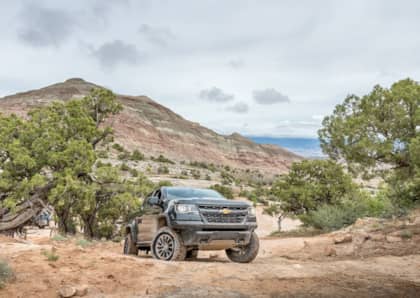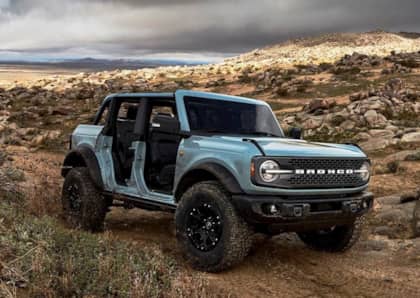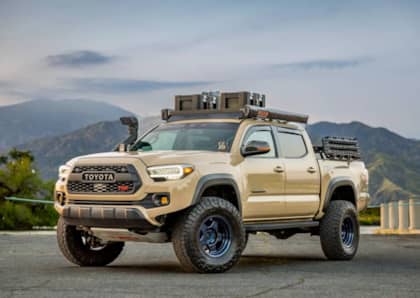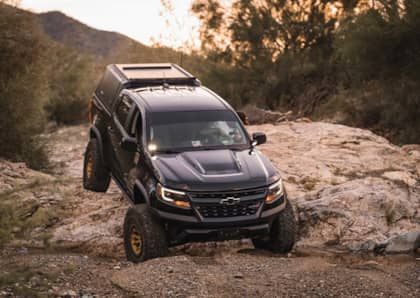2020 Chevrolet Colorado ZR2 Review: How Does The Mid-size Off-Road Pickup Stack Up Against The Toyota Tacoma TRD Pro?
When Chevrolet came back to the mid-size truck segment with the redesigned Colorado, it knew it would have to work hard to peel buyers away from the Toyota Tacoma, which had been a segment stalwart for the previous two decades. One of the chief weapons at its disposal was the willingness of General Motors to invest heavily in a special edition model aimed squarely at the heart of the off-road junkies.

Dubbed the Chevrolet Colorado ZR2, it was the first true innovation in the entry-level 4x4 segment in more than 10 years. Riding on a trick suspension setup that had previously been installed exclusively on world-beating supercars and track-only open wheel racers, the ZR2 faced down its Tacoma TRD Pro foe with a steely eye and won many converts with its off-road alacrity.

We're now several years into the ZR2's challenge to TRD dominance, and the pickup's very existence has forced Toyota to up its own game by continuing to refine the TRD Pro package for the Tacoma. How do the two mighty mid-sizers match up after all this time?
Breaking New Ground
When Chevrolet first put together the ZR2 spec, it both borrowed from past models (the Blazer and S-10) and combined it with class-leading technology that broke new ground for truck buyers.

Visually, the ZR2 stands through its wider track (3.5 inches versus the standard Colorado), fender flares, and trimmed front and rear bumpers, the latter of which are intended to improve the vehicle's approach and departure angles. Keen eyes will also spot standard rock sliders along the rocker panels and 31-inch tires wrapped around 17-inch wheels (along with an induction-look hood). The Colorado ZR2 also rides two inches taller than stock.

It's what's not visible to the naked eye that makes the Chevrolet such an intriguing option, however. The ZR2's shock absorbers use something called dynamic suspensions spool valve (DSSV) technology. Developed by race car builder Multimatic, the technology is used in Formula 1 racing and Indycar, as well as on sports cars like the Ford GT and the Chevrolet Camaro Z/28.

DSSV uses spool valves to replace shims inside a shock absorber to provide much more precision in controlling the flow of hydraulic fluid, and by consequence the up-down motion of the shock piston. Far more robust than a traditional shock design, the valves are extremely resistant to wear as a result of time and abuse, and they also offer a linear damping curve in relation to the speed and position of suspension movement that's difficult to replicate with shims.

Also joining DSSV shocks on the list of invisible ZR2 upgrades are a pair of electronically-locking differentials front and rear, a set of cast-iron control arms, and an 'Off-Road' driving mode that takes into account lower traction situations when dialing in throttle response and stability control intervention.
Old School, But Computerized, Too
Despite offering a less advanced suspension design, the Toyota Tacoma TRD Pro is no joke. In fact, its old-school attributes are a big part of why the truck is so popular, as its prized reliability factors big into purchase decisions for local Taco fans.

The Tacoma TRD Pro steps up from the TRD Off-Road by way of its Fox shocks (2.5-inches in diameter, with an internal bypass and a remote reservoir), as well as an additional inch of lift at the front of the truck.

Wheels are 16-inchers, a TRD exhaust system is present and accounted for, and quarter-inch aluminum skid plates are tucked underneath to protect the delicate bits of the undercarriage. Approach and breakover angles are more aggressive for the TRD Pro, too.

The truck also includes an electronic locking rear differential and a crawl control system intended to help reduce stress when stuck in soft sand or climbing up or down a steep grade. Finally, Toyota's 'Multi-terrain Select' system further dials in the vehicle's traction control system to process the ground below its tires with as little wheel spin as possible.
Double-Up With Diesel
In terms of drivetrain, the 2020 Chevrolet Colorado enjoys a sizable advantage over the Tacoma TRD Pro. Both the standard 3.6L V6 (308hp, 275 lb-ft of torque), and the optional 2.8L turbodiesel Duramax four-cylinder engine (186hp, 369 lb-ft of torque) are far more modern than the 3.5L V6 (278 horsepower, 265 lb-ft of torque) found in the Toyota, which also doesn't have a diesel on the order sheet.

That being said, if you want a manual gearbox you'll have to stick with the TRD Pro, which still provides a six-speed shift-it-yourself transmission to go with its six-speed automatic. The Chevrolet includes a pair of automatics (six-speed for the turbodiesel, eight-speed for the gas engine).
Two Different Experiences From Two Capable Trucks
How do the two trucks stack up when put head-to-head on the trail? Despite their differences both the Chevrolet and the Toyota are quite capable, although it's a tale of two distinct experiences.

The Colorado ZR2's DSSV suspension provides exceptional control when parsing rough ground at both high and low rates of speed, with much less bounce and chatter from the chassis as compared to the Tacoma TRD Pro's Fox shocks. It's definitely the truck to get if you enjoy a desert run or a quick dash across the wash.

When the going gets slow, the Chevrolet's locking differentials provide a more granular tool for experienced off-roaders, while the Toyota's crawl control system lets you sit back and steer as it does a solid job of maintaining a safe rate of forward progress. It's a question of computers versus gearing, and these two aspects of the off-road drive are the primary difference makers when sampling the trucks back to back.

On the pavement, the ZR2 outclasses the TRD Pro when it comes to handling. Once again DSSV makes an enormous difference in terms of comfort and control, with none of the dive, shake, or body roll associated with the Toyota's external reservoir shocks. There's very little sacrifice in day-to-day ride quality when contrasting the ZR2 to the regular Colorado, which is not the case for Toyota's tough truck to commuter comparison.
Head-To-Head
Fairly evenly matched in the tough stuff (and in terms of price, with both trucks hovering around the $45,000 mark when well equipped), the 2020 Chevrolet Colorado ZR2 is clearly the better choice if you plan to daily drive your rugged off-road truck. In addition to the Tacoma's rough ride, its interior also comes across as somewhat spartan, making the ZR2 feel like a higher-end choice. If you want better fuel mileage and class-leading torque, and don't mind paying a few thousand dollars extra, then the Chevrolet is also going to deliver thanks to its available diesel engine.

Chevrolet knew from the start that it would have to impress with the ZR2 to even get Tacoma fans to turn their heads in the Colorado's direction. It's a classic case of over-achieving, and it works out to a win for off-road fans willing to break with the Toyota hegemony and try something new out on the trail.
More From Driving Line
- What's it like to live with the Chevrolet Colorado ZR2 on a long-term basis? Check out our real-world review of Chevy's ZR2 truck.











